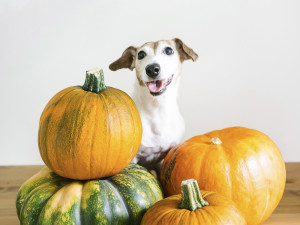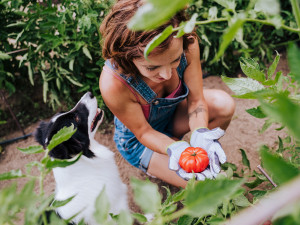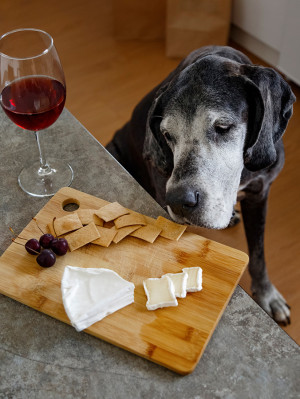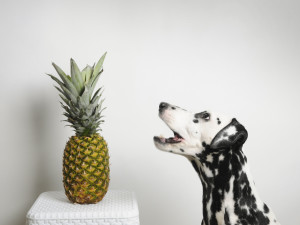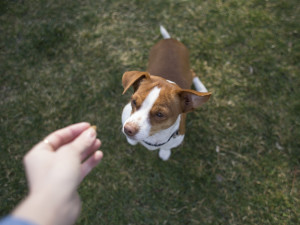Can Dogs Eat Lettuce?
Learn if they can get in on some of your salad.

Share Article
In This Article
Can Dogs Eat Lettuce? How to Feed Your Dog Lettuce What Other Greens Can Dogs Eat? Can Lettuce Settle a Dog’s Stomach? What Happens if a Dog Eats Too Much Lettuce?
Ever find yourself eating a salad for lunch and wondering if you can share with those big, brown eyes looking lovingly up at you? Lettuce is good for you, but is it good for your dog? It’s a fair question you should ask anytime you consider giving people food to your pup. Many human foods are toxic to dogs, so you may have to research before you consider sharing them. Meanwhile, we’re here to answer your question about lettuce. Let’s explore the facts and considerations.
Main takeaways
Dogs can eat lettuce in moderation.
The best varieties for dogs are arugula, iceberg, and romaine.
Always chop the lettuce up into small pieces.
Lettuce is best for dogs when steamed.
Other greens that dogs can eat are green beans, zucchini, and carrots.
Can dogs eat lettuce?
We could simply answer yes, but there’s so much more you need to know about dogs eating lettuceopens in new tab.
Is it safe for dogs?
Certain varieties are safe in moderation and if certain considerations are followed. For example, romaine, iceberg, and arugula are non-toxic, but only in small amounts as an occasional treat. There are safety issues to consider:

Large lettuce leaves can be difficult to chew, especially for small dogs. The leaves must be chopped into small, bite-sized pieces to prevent choking.
Commercial lettuce may have been grown with pesticides or other chemicals. It can also transmit E. coli, listeria, and salmonella. To avoid these germs, you must wash lettuce thoroughly before eating it.
Do not share your salad or other form of lettuce if it contains dressings, seasonings, or ingredients such as onions and garlic, which are toxic to dogs.
Lettuce can be an excellent dog treat if given in moderation, plain, chopped, and thoroughly washed.
Can it be good or bad for certain dogs?
Not every dog can eat lettuce. For example, its low caloric content is perfect for overweight dogs. However, if your dog is allergic to it (rare), stop feeding them lettuce immediately. Dogs with sensitive stomachs may be unable to eat it without developing diarrhea and excessive gas. So, lettuce can be good for some dogs and bad for others. Generally, most dogs tolerate it well.
How much lettuce can dogs eat?
Moderation is essential. Small dogs should only have a few small pieces. Medium to large dogs can have one or two leaves chopped into small pieces. In addition, lettuce is meant to supplement a small part of a meal or be given only some days. It can be given occasionally as a treat.
How to feed your dog lettuce
If you decide to share your salad or some lettuce from your burger with your dog, follow these tips to feed it safely and keep it an enjoyable experience.
Don’t mix it with herbs or dressing
Avoid dressings, herbs, and other ingredients, such as onions or garlic, which are toxic to dogs. Fatty dressings can lead to intestinal issues, even pancreatitis. Always serve your dog plain lettuce.
Wash it carefully
When lettuce is brought home from the store, dirt, bacteria, and pesticides can remain. Always rinse lettuce thoroughly under running water before serving. Organic lettuce is a better choice to minimize exposure to chemicals.
Steam it for easier digestion
Steaming lettuce is an easy way to make lettuce more digestible for your dog while preserving its nutritional benefits. It can make it more tolerable for dogs with sensitive stomachs or those with difficulty chewing raw vegetables. Avoid overcooking, as this can reduce its nutritional value.
To steam lettuce for dogs, use fresh lettuce, romaine, iceberg, or arugula. Avoid lettuce mixed with additives. Wash thoroughly under running water to remove bacteria, pesticides, or dirt. Chop into small pieces to reduce choking hazards, especially for small dogs. Add lettuce to the steamer, cover the pot with a lid, and bring the water to a boil. Steam for one to two minutes or until it is slightly softened but retains some of its structure. Overcooking can strip the lettuce of its nutrients. Cool the lettuce completely. Serve plain.
Monitor quantity: Only offer a small portion, as lettuce should be an occasional treat, not a dietary staple.
Test tolerance: Start with a small amount to ensure your dog tolerates it well.
Store leftovers: Steamed lettuce can be stored in an airtight container in the fridge for one to two days. Ensure it is fresh before feeding it again.
What other greens can dogs eat?
If feeding your dog lettuce succeeds, you may ask what other greens they could safely eat. Here are some options:
Spinach: Rich in iron and vitamins, but should be given in moderation due to oxalates, which can affect calcium absorption and are not suitable for a dog with kidney disease
Green beans: An excellent low-calorie snack that’s high in fiber and vitamins
Cucumber: High in water content and perfect for hydration
Kale: Nutrient-dense greens, but also high in oxalates and isothiocyanates, so dogs with kidney disease should also avoid it.
Oxalates can bind with calcium in the body to form calcium oxalate crystals. These crystals need to be excreted, but in dogs with kidney disease, their kidneys may not function properly, reducing their ability to process and excrete these crystals efficiently. Excess oxalates and the crystals they form can lead to the formation of calcium oxalate stones (kidney stones) in the urinary tract. These stones can cause blockages, which are especially dangerous for dogs with compromised kidney function. Dogs with kidney disease already have reduced kidney function. They have a difficult time filtering out waste and maintaining electrolyte balance. Oxalates can make this situation even worse and possibly speed up the progression of kidney disease.
If a dog with kidney disease consumes too many oxalates – such as those in spinach and kale – symptoms might include:
Painful urination
Blood in the urine (hematuria)
Straining to urinate or inability to urinate (a veterinary emergency)
Lethargy
Vomiting or loss of appetite
For dogs with kidney disease, it’s best to avoid feeding kale and other high-oxalate foods (e.g., spinach, beet greens). Instead, consider safer, lower-oxalate vegetables, such as green beans, zucchini, or carrots. These are nutritious and less likely to cause complications. However, always consult your veterinarian before introducing new foods to a dog with kidney disease.
Can lettuce settle a dog’s stomach?
Lettuce is not a remedy for an upset stomach. The fiber in it can help with digestion by promoting regular bowel movements. However, an upset stomach is best treated with lean protein, rice, or pumpkin.
What happens if a dog eats too much lettuce?
If your dog consumes too much lettuce, they may experience side effects such as:
Excessive gas from the fiber
Diarrhea
Choking if they eat too much too fast and the lettuce is uncut
Lettuce is generally very safe, but if your dog develops intestinal issues or lethargy, call your veterinarian. Any change in diet can always have unexpected effects on your dog’s health.
References
Jensen, A. N., et al. “Escherichia Coli Contamination of Lettuce Grown in Soils Amended with Animal Slurry.” Journal of Food Protection, vol. 76, no. 7, July 2013, pp. 1137–1144, https://doi.org/10.4315/0362-028x.jfp-13-011opens in new tab.
Kim, Moo Jung, et al. “Nutritional Value, Bioactive Compounds and Health Benefits of Lettuce (Lactuca Sativa L.).” Journal of Food Composition and Analysis, vol. 49, June 2016, pp. 19–34, https://doi.org/10.1016/j.jfca.2016.03.004opens in new tab.
Morris, Penelope J., et al. “Safety Evaluation of Vitamin a in Growing Dogs.” British Journal of Nutrition, vol. 108, no. 10, 1 Mar. 2012, pp. 1800–1809, www.ncbi.nlm.nih.gov/pmc/articles/PMC3513714/, https://doi.org/10.1017/s0007114512000128opens in new tab.
Soffer, Nitzan, et al. “Bacteriophages Safely ReduceSalmonellacontamination in Pet Food and Raw Pet Food Ingredients.” Bacteriophage, vol. 6, no. 3, 2 July 2016, p. e1220347, https://doi.org/10.1080/21597081.2016.1220347opens in new tab.

Dr. Shelby Neely, DVM
Dr. Shelby Neely is a freelance writer and veterinarian who graduated from the University of Pennsylvania School of Veterinary Medicine and has practiced veterinary medicine for 30 years, specializing in small animals. Her work has appeared in Allivet, AsktheCatDoctor, WhiskerDocs, Ask the Cat Doctor Radio, Ask the Cat Doctor TV, and numerous other websites, brochures, newsletters, newspapers, and ebooks. In her spare time, Dr. Neely likes to spend time with her three children, two grandchildren, three cats, two grand-cats, and five grand-dogs.
Related articles
Can Dogs Eat Pumpkin?
This superfood is delicious and full of nutrients—but how much is too much of a good thing?
Can Dogs Eat Tomatoes?
Bite-size pieces of ripe, red tomatoes are safe—but you should skip the marinara sauce.
Can Dogs Eat Cheese?
We know they want to — but how much is safe?
Can Dogs Eat Pineapple?
Pineapple is a healthy, sweet treat for dogs—as long as you feed it to your pup in moderation.
![A woman smiling at her dog while carrying a bowl of food.]()
Can Dogs Eat Yogurt?
Yes, yogurt is a safe and healthy treat for dogs.
Can Dogs Eat Almonds (and Other Nuts)?
This healthy snack for humans isn't so healthy for your pup. Here's why it's best to avoid them.
